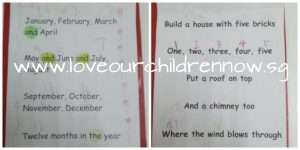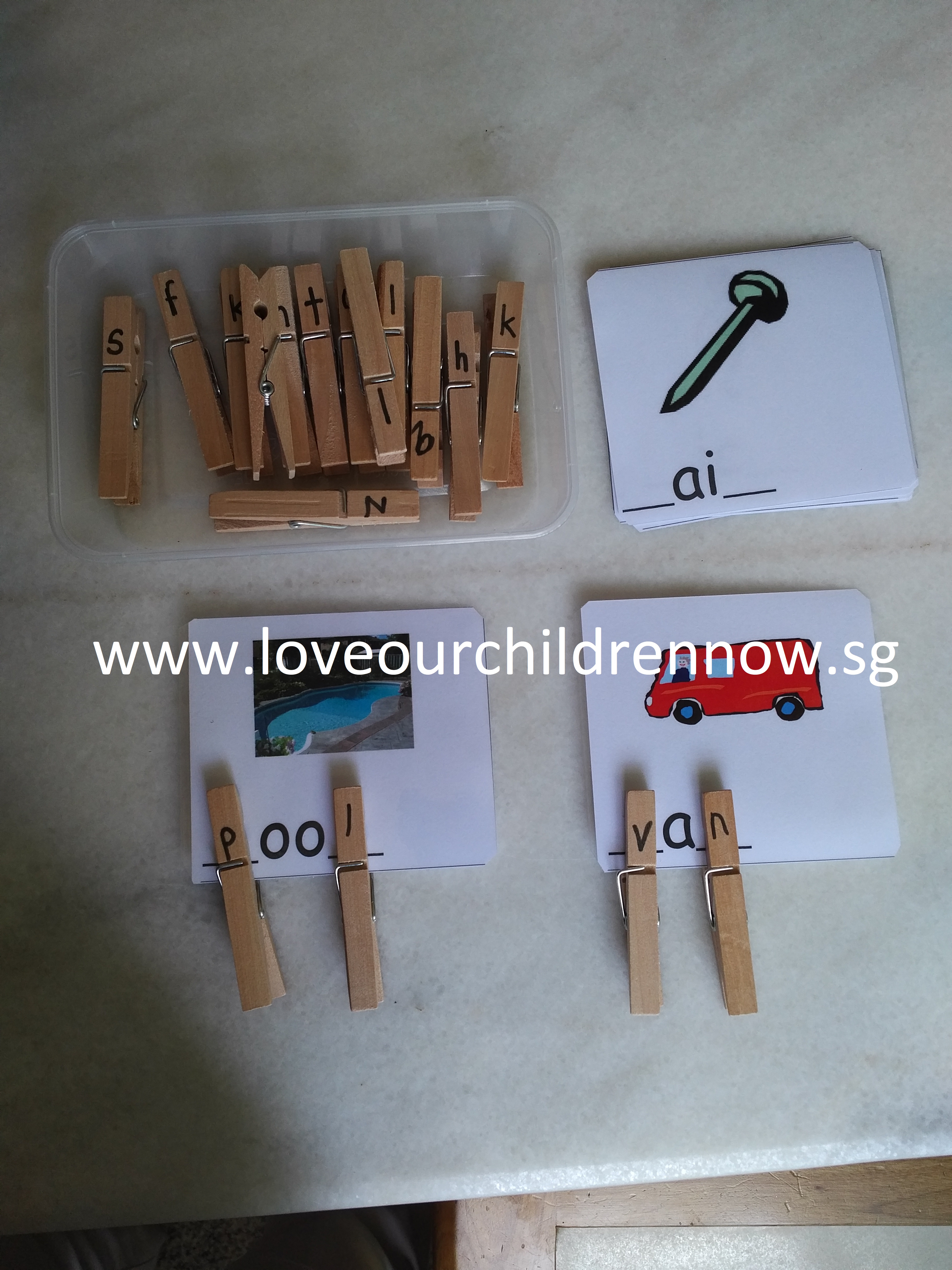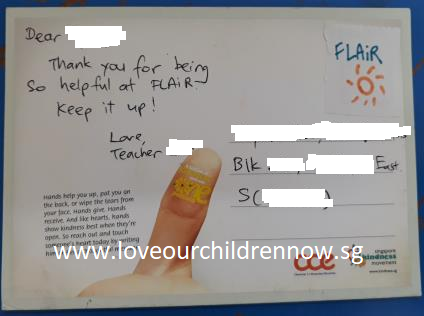FLAiR – Instilling a pre-disposition towards Reading
Besides making Samuel a reader for the past 8 years, I had spent the past two years working as a Pro-FLAiR (Focused Language Assistance in Reading), under AECES (Association for Early Childhood Educators (Singapore)).The programme is targeted at K2 students who are not meeting benchmarks for reading and writing. It is not a Phonics programme. Instead, its aim is to cause children to fall in love with the English language therein helping them pick up the language naturally, i.e. instilling in them, the pre-disposition towards reading.
The work hours suited me perfectly, as FLAiR happens only during the school term, and I decided to just take one class, which means I worked for only an hour a day. I could do it, and continue to spend time with Samuel. It was also very meaningful and fulfilling work because the children responded very well to the programme – I saw them blossom, not just in their reading/writing but also in their confidence and character.
I have moved on to do other things, but I wanted to document some of my favourite activities with my FLAiR children. These are also the ones which I was most proud of because they train academic and learning skills, on top of language. I indicated the learning benefits of the activities in italics:-
1) Story-Books related activities
At FLAiR, we read aloud for the children every day. (The FLAiR resource kit includes more than 50 story books; pro-FLAiRs would supplement them with our own books, or books from the library). We were told to do “one new, one old, and one favourite” book a day. I would get the children to pick a book each and I will read it for them. Some children ask to read the same books day after day.
For some books, we just read and enjoy. For others, we do activities based on them. The FLAiR resource kit includes many ideas, but Pro-FLAiRs also create many new activities; we do our own research and learn from one another. As a community, we met once every quarter for a Learning circle, and within our own cohort, we generously shared ideas and resources.
For me, after I have read the book “Brown Bear, Brown Bear, What do you see?” by Eric Carle, I did a series of activities on Animal homes. The children played matching games of animals to their homes. They also played the game of putting the animals in the order in which they appeared in the story. Besides learning information, these games train the children’s memory and teach them to distinguish and categorise (Bee with Bee hive; Fish with Fish-tank).

Obviously home-made.
Pro-FLAiRs use their own resources to create learning materials.
Once a year, AECES appreciate the Pro-FLAiRs
by giving us stationaries like coloured paper and laminating sheets.
Nonetheless, Pro-FLAiRs have to be resourceful
and find a way to utilise those resources.
After reading the book “Mrs Wishy Washy”, I got the children to make their own clothes (they draw them on paper, colour and cut them out). I brought a thick string and some clothes peg. The children hung their clothes up on the washing line. Children get to design their own clothes, exercising creativity; they cut the items out and hang them up, practising fine-motor skills; they see their own creation displayed, feeling a sense of accomplishment and ownership.
2) Calendar activities
There are other stand-alone activities that pro-FLAiRs create from scratch. This set of Calendar activities is my original creation, and my ultimate favourite.
I let each child have his/her own desktop calendar. I would have my own too (I collect these from friends). I would play a game of getting the children to flip the pages of the calendar – month by month – from January to December, while shouting out the name of the month. Most of them have no idea what the word “January”, “February or “March”, etc looks like. But they may understand the concept of sequence and will simply flip a page. This helps the children understand the concept of the passage of time – a very abstract principle. It also helps train some children on the concept of sequence. It also trains their fine-motor skills through manipulating the calendar.
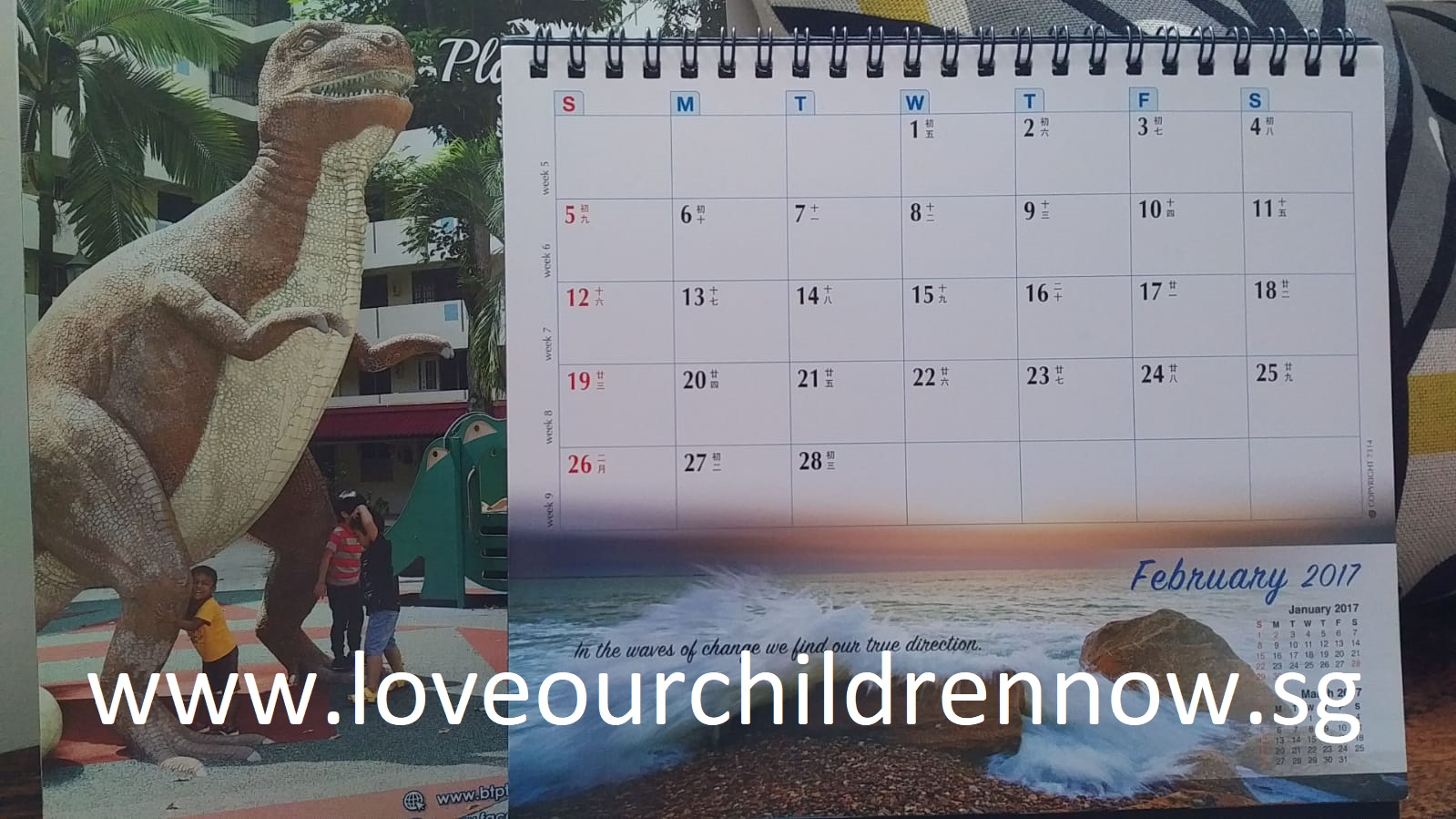
Calendars have beautiful and interesting pictures in themselves.
The children enjoy looking through their own calendars
while doing the activities.
I start the children on print-awareness and word recognition by guiding the children, asking them questions like “What letter does February start with?” Someone in the class would answer, and I would get them to check, whether they are at the right month. Some children will be more advance than others. This gives those children the chance to help their classmates – it builds their confidence and it can spur the others. For those who need my help, I will direct them straightaway. We must always help the children to succeed, especially in group activities. Once a child gets discouraged through his/her inability to keep up, it is difficult to get the child to continue trying.
After a while, after the children have gotten familiar with the game, and are more able to recognise alphabets, I will get them to spell out the months. It is an easy activity because they just need to read off the alphabets on their calendar. This is another opportunity to help the child succeed – the child feels like he is able to spell. It is also a form of getting the child to learn to spell visually (he sees the word and alphabets), vocally (he articulates the alphabet) and auditorially (he hears himself).
I also get the children to find their own birth-date in their calendar and draw something in the space. The child practices looking through the calendar to find a particular date. Indicating his birthday gives him a sense of value and importance. The children would sometimes want to write in the birth dates of their parents, siblings and friends – even mine. The child develops socially. It also gives meaning to what they are learning – “numbers and words have a purpose”. They also learn the usefulness of the calendar.
One of the FLAiR resources we get are notebooks with blank squares. The children are to write the months and the dates into the blanks. We usually get those resources only in March. By that time, my children would be familiar with the calendar I had given them earlier. They would then use those calendar as a reference, to copy the dates into their calendar. The children learn to copy – which builds their hand-eye co-ordination – an essential academic skill. The format of the FLAiR calendar is usually different from the regular calendar, so the children have to take extra care. Nearly every one of them will make mistakes in their copying at least once. They will then have to re-do. The only way to build resilience is to practice getting up when you fall. So when they make mistakes, they have to practice building resilience. It is difficult for them, so this has to be done very gingerly. I give them lots of encouragement (dramatic and exaggerated if needed) and gentle nudging to not give up. I watch their facial expression and body language. If I discern that they are about to melt-down, I would offer to erase it for them. Never push the child too hard – learning has to be done incrementally, according to the child’s capacity to withstand the strain of being stretched.

This child insists on using a colour pencil to write in the numbers,
although it makes it harder for him to erase when mistakes are made.
He also insists on filling the whole box with the number,
leaving little space for him to write/draw anything else.
In the spirit of FLAiR, we let the child do it his way.
We give the child the dignity of making his own decision
and allow him to learn, independently,
the practical reasons why things are done a certain way.
It causes him to “own” his own learning.
To top off my calendar activity, I borrow a particular series of books from the library. These books have interesting holiday for each month, e.g. National Popcorn day, National Grandparents’ day, National Hippo day. I will let the children look at the pictures and they can draw them in their calendar. This gives meaning to words and books. It gives me information on the children (what interests them, who likes/does not like to draw/colour).
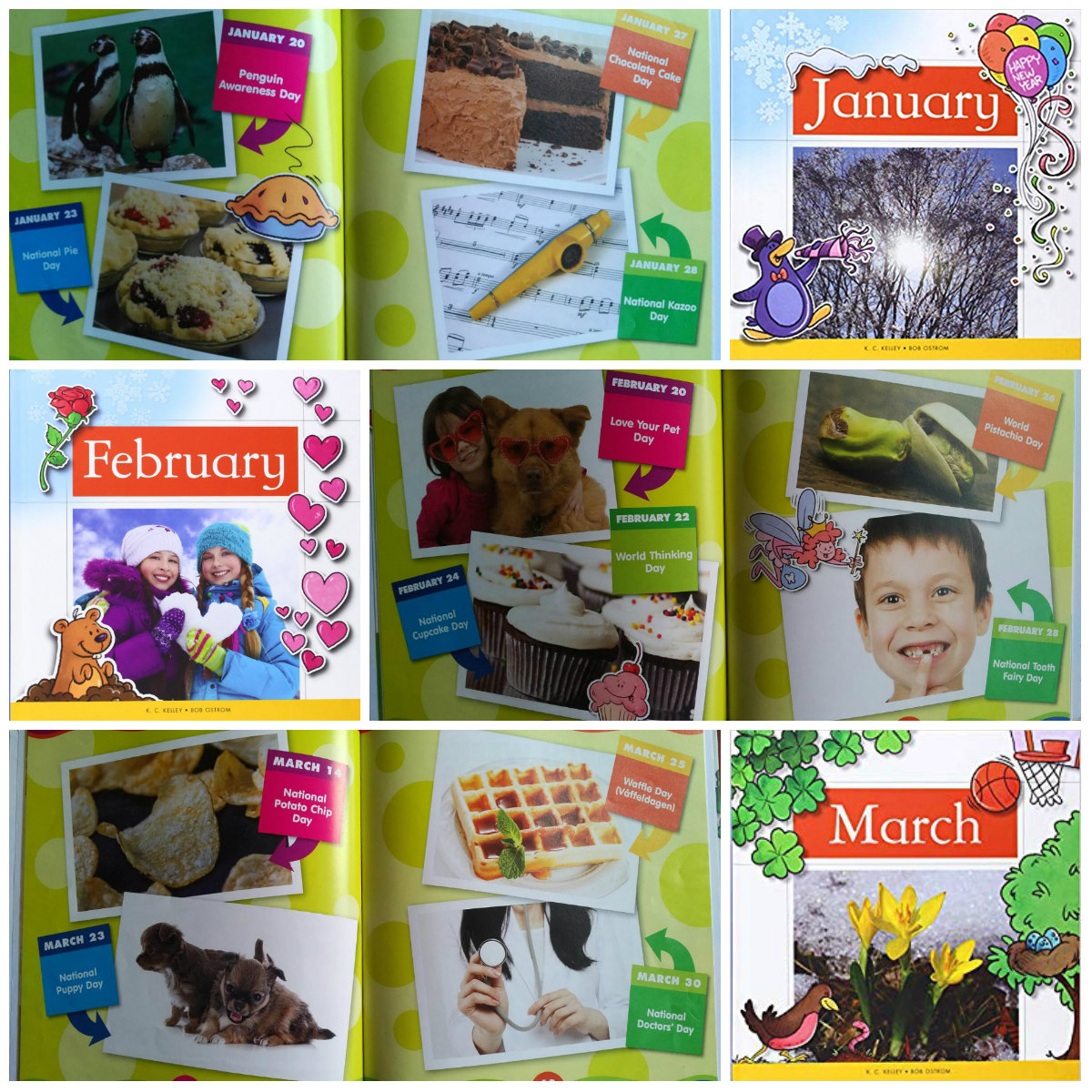
This is a series of book written by K.C. Kelley, Bob Ostrom.
You may borrow them from the national library.
The pictures are so pretty, don’t you think?
3) Songsheet activities
Another of my original (as far as I know) activity is Songsheets. This is my second favourite activity.
I would type out words of songs which the children already know, e.g. ABC song, Months of the year, etc, and make them into A3-size songsheets. I would put it up in front, and point at each word of the song, as the children sang. Then I would have each of them come up in turn to be a “teacher” to point at the words. Some children did not yet have print awareness, i.e. they do not know that the symbols of the alphabets join together to form a word. They did not know that these alphabets/words “makes a sound”, and some words have more than one syllable. These are not possible to teach – the child has to “catch” it. Pointing while reading helps them to “catch” it, i.e. gain that awareness.
I would then get the children to come up, in turn, to the A3 page to “decorate” the songsheet, e.g. write “1” on top of “January”, circle “F” “L” “A” “I” “R” on the page, circle all the “and”, underline all the “the”, or draw a person on top of the word “you” and so on. This is to help the children to start recognising alphabets and simple words.
I would then print out A4-size copies of the same songsheet for each child. Each child will then “decorate” their own songsheet the same way we did the A3 songsheet as a class. The repeat exercise of doing on the A4 sheet, what they might have already done on the A3 sheet, serves as a review for the child. The child is also practising how to “copy from the board”, which requires good hand-eye co-ordination – an essential academic skill. The children are also allowed to decorate their songsheet with any kind of drawing. Children desire ownership, i.e. they desire to own things. This activity gives them ownership, builds their confidence and gives them a sense of control.
The children will go through 4-5 songsheets throughout their time with me. I leave the A3 sheets pasted up on the walls of the FLAiR area while each child keeps their personalised songsheet. The A3 songsheets serve as the “Third teacher“. The A3-sized songsheets also serve as a “dictionary” for children to refer to, when they need to spell some words. Referring to these resources trains the children to be independent learners and teaches them problem-solving skills. I also use the songsheets with individual children for them to “sing back” to me, while pointing at the words. Each time I do it, it is a form of review for the child.
Some children may not actually recognise the words, but because the words have been “decorated”, it helps the child spot words. This teaches the child how to use “handles” (in this case – the decorations) to help them learn, gives them a sense of accomplishment and builds their confidence.
4) Word-Recognition activities
FLAiR is not a reading programme. The philosophy behind it is that if we keep exposing children to print, and make print meaningful and interesting for them – they will start to be motivated to read/write, and start to pick up reading/writing. As a trained academic therapist however, I cannot help but put in activities which are purely for word recognition (as you can tell, from the calendar and song-sheet activities). However, they are sneaked in, so the children do not know or feel that they are being “taught”.
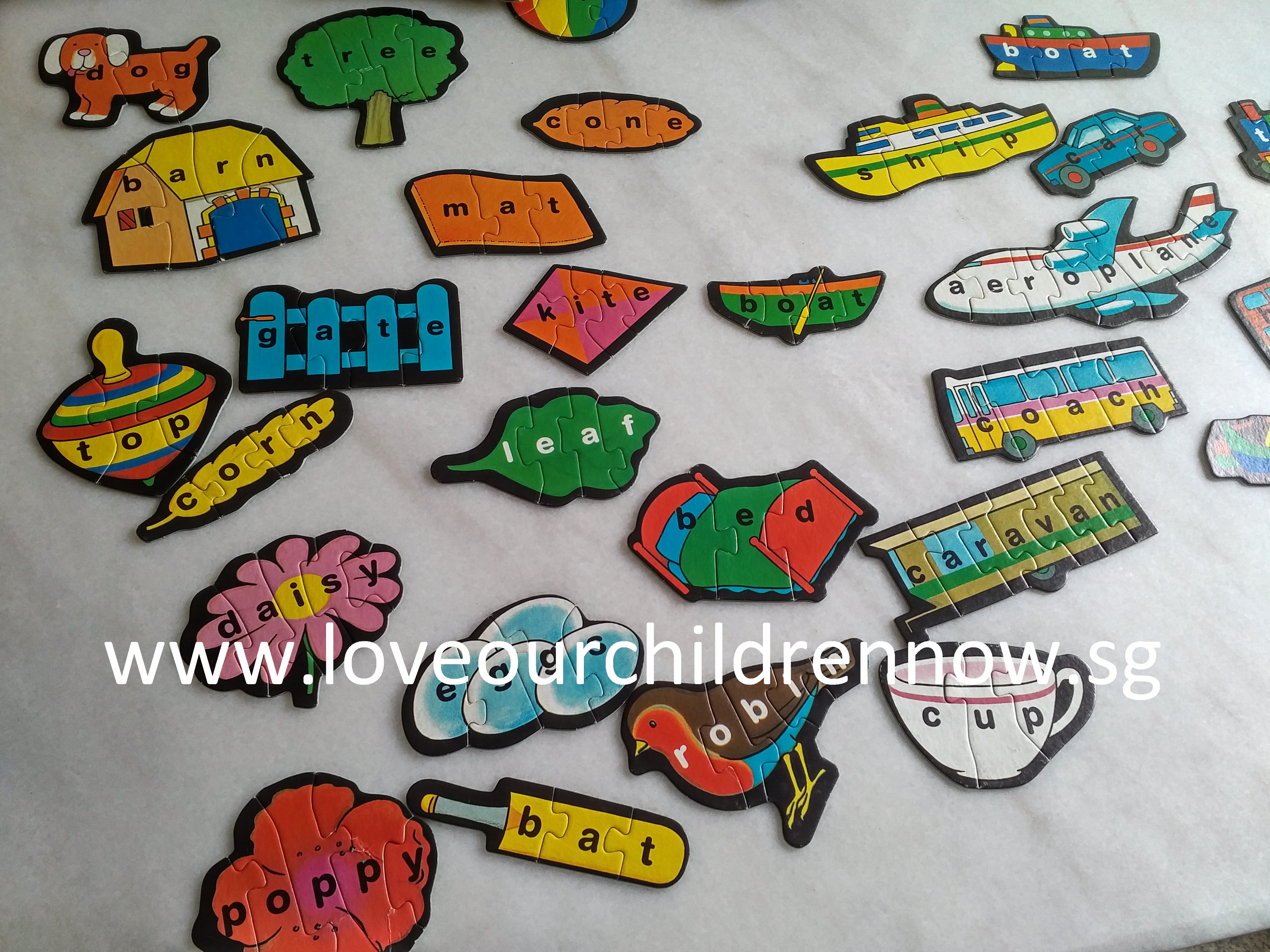
In FLAiR, we practice differentiated learning.
What this means is this,
while we conduct group activities targeting everyone,
we also spend time with individual children to address their gaps.
So there is a need for us to design activities for independent learning.
This is one of the children’s favourite free-choice activity for independent learning.
I start the children on activities that involve word-recognition only after they have become more competent. I reiterate, it is important to help the child experience success at every learning activity.
I teach them the nursery rhyme “Hey diddle diddle” and put the rhyme up in front. Then I give them individual “cut-out words” of the rhyme. They put the rhyme together, using the intact rhyme as a reference. Children always enjoy playing with puzzles – this is like a puzzle to them. I start it as a group activity (each child takes one line). Then I let them do it individually and complete the whole rhyme. After the child gains competency in forming the rhyme using the reference, I get the child to do it without the reference. So the child is led progressively to achieve more and more.
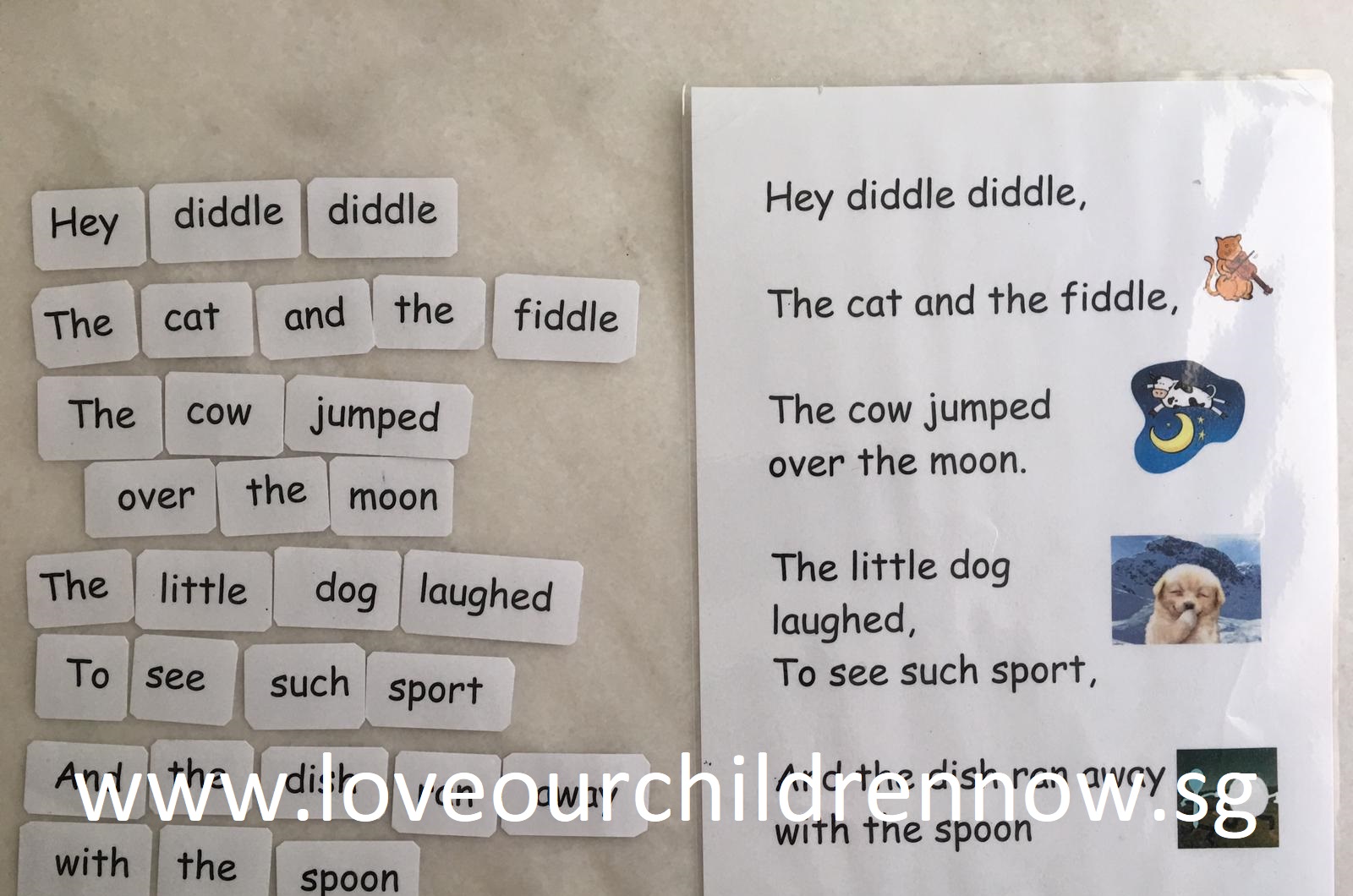
I also do a little dramatization with this rhyme.
I brought toy items (dog, cat, cow, dish, spoon, etc)
and got the children to act the story out.
They loved it, and it helped them remember the rhyme.
I use the same idea for the National Pledge. I will teach them the pledge, and give them individual “cut-out words” of the Pledge. They will put the Pledge together, again using the intact Pledge as a reference. As the Pledge is a much longer passage, with more difficult words, I shaded different words in different colours, to make it easier for the children to identify the words.
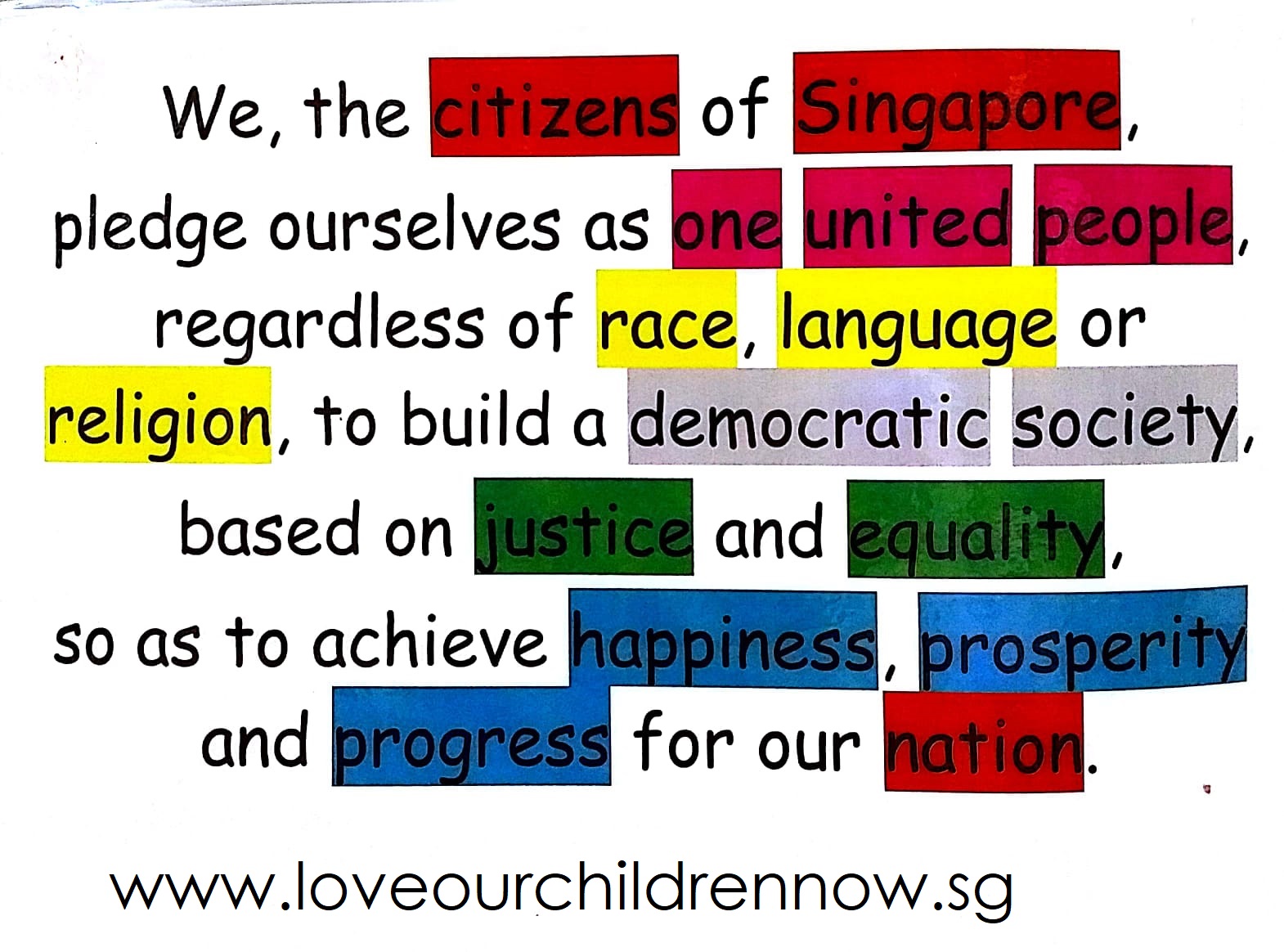
The down side for this activity,
is that it takes a looooong time to prepare.
Did you know there are 38 words in our pledge?
Well, now you know.
I also had to ensure the children
do not get their words mixed up with their friend’s.
The children will paste the Pledge into their notebooks. One child enjoyed her pledge so much that she would take it out during every FLAiR session to read it aloud to me.
I also let them play with “Word-sentence” puzzles. I coded the difficulty level of the puzzles so they start with the easiest and go on to more difficult puzzles. (I downloaded this from the internet, but I cannot remember where I got it from).
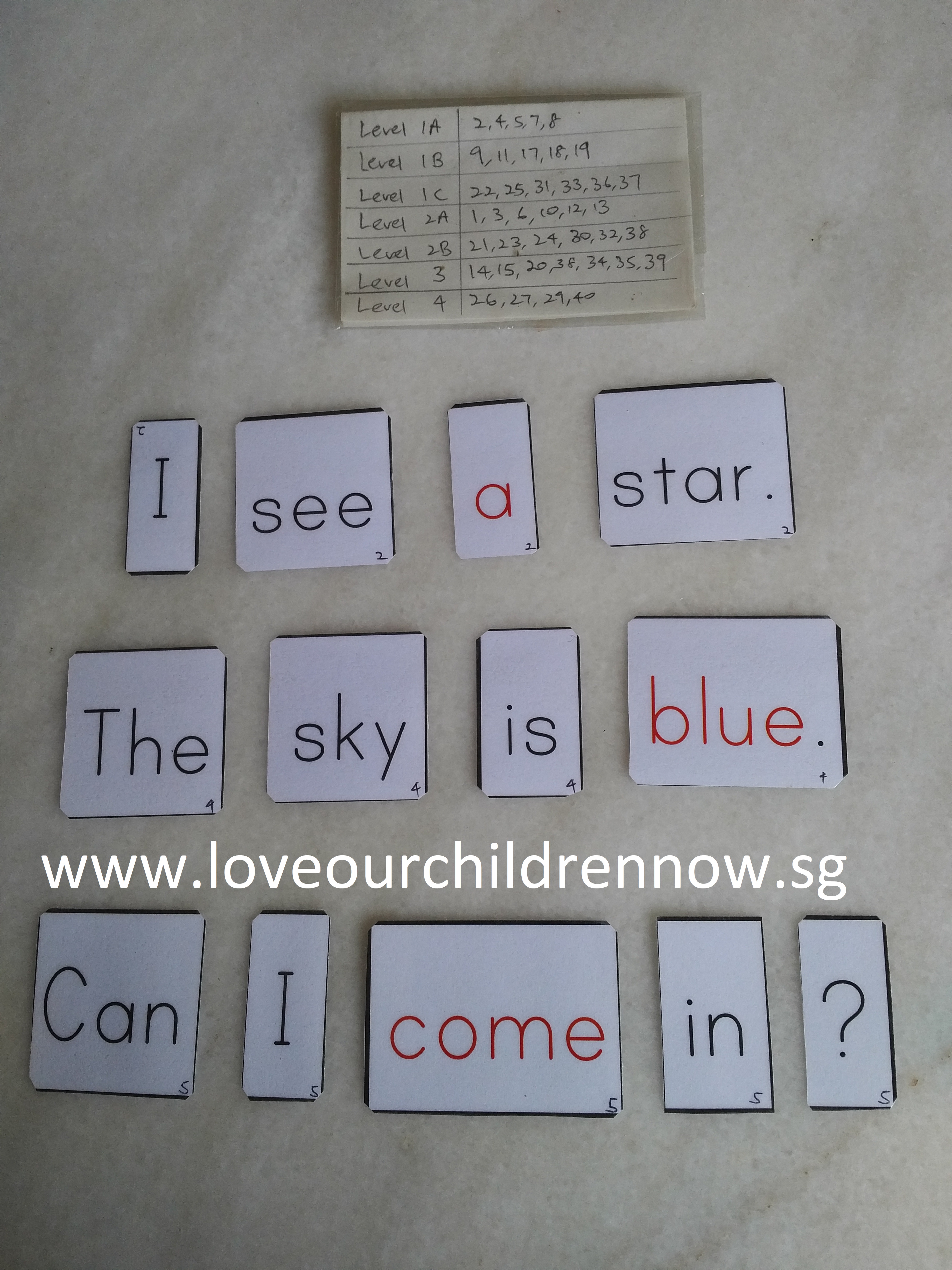
I love this activity,
because I can use it to
also teach the children about punctuation
– the sentence starts with a uppercase letter,
and ends with a full-stop or question-mark.
I teach them to use that as “clues”
for putting the puzzle together.
I also created “spelling” games, with word-picture cards and alphabet-clothes-peg. I used simple words like “pool” and “book” with missing “p” or “k”. Then, I get them to clip the alphabet-clothes-peg onto the missing alphabet. The game is self-checking, and is limited in its difficulty, as there is an exact number of alphabet-clothes-peg in each box – one for each missing alphabet.
When introduced at the right stage (when children have become more competent), these reading/spelling activities are very empowering. Everyone enjoys achieving. Once the children are able to read, they enjoy reading activities because they are “hitting target” with every word which they read. It is the same for the spelling game. (One child kept exclaiming: “I can spell! I know how to spell!”).
5) Games
I let the children play with both commercial toys and home-made games. Every one of the game featured here serves a purpose towards academic learning.
We used play-doh and alphabet cookie-cutters to form letters of the alphabets. It strengthens their fine-motor skills and engages their kinesthetic senses to learn the alphabets. For those who are able, they will form simple words. I will help them form words by making the phoneme and guiding them to identity the correct alphabet. This is an early form of spelling.
I create games for the children to thread macaroni and pick green beans. These strengthen their fine-motor skills.

Pro-FLAiRs create these games to help the children
learn high-frequency words.
For Snakes and ladders and Tic Tac Toe,
the children have to read the words when their token lands on the box.
For “Feed the rabbit”,
they have to read the words before
they can feed the rabbit the carrots.
We played the “Whisper game” (I made it very simple, e.g. “Good morning”). It is a game which improves their listening and articulation. The FLAiR resource kit includes the “Listening Lotto Game“. It is simple to play and useful for training listening skills. I played “Simon Says”. It trains the children in listening skills. It is also a useful classroom management tool. I use it to help the children work off any excess energy and get them to sit down by saying “Simon says sit down!” as the last instruction for the game.
I brought a “Surprise box” of little toys, representing different items, e.g. spider, sandwich, STOP sign, stingray. There would be 12 items and I would name them and talk the children through the items. I would ask the children to remember as many items as possible, and then close the box. They would then be sent to different parts of the room to draw all that they have seen. This trains their memory.
The children loved this game, although it took a while for some of them to pick up the technique of committing things to memory – a critical academic skill. One child will tell me “he is ready” before the time is up, but found that he could only recall a few. The second time I let the children look at the objects, he had wisened up and took effort to study and remember.
6) Other activities
We played the game of “Be a teacher”. I use the FLAiR resources for this – the alphabet cards (e.g. a picture of the “jet” on one side, and the word “jet” on the other side), and the ABC pocket chart. I do this activity only after I have introduced all the letter sounds to the children.
I put all the alphabet cards in a feely bag. The children will sit down and each one will come up in turn to “be the teacher”. I let the teacher-child draw out a card from the feely bag, and give it to me. I will show the child the picture, e.g. picture of the jet, and ask the child, quietly so the rest cannot hear – “What is this?” “jet”, “What is the beginning sound?” “/j/”, “What letter is that?” “j”. In the event that a child can’t answer the questions, I will tell the child the answer, but only after giving the child time and the chance to think and respond. We always help the child to succeed. If the child does not know, we should just tell him. We must do it nonchalantly- without judgment, fanfare or drawing attention to the fact that the child does not know. DO NOT say – “You don’t know? You don’t remember? Did I not teach you this? How many times have I taught you this?”. On the other hand, some children need more time to think, so we must give them that time, because each exercise of straining to recall will improve the recall mechanism for the next time.
The teacher-child will then turn to the other children, and ask the same three questions. “What is this?” “jet”, “What is the beginning sound?” “/j/”, “What letter is that?” “j”. The children loved this activity and some of them improvise at the end by giving their friends pretend-stickers, gifts, etc. The teacher-child will then put the card into the correct alphabet pocket in the ABC pocket chart. The child goes through a few learning activities – recognition of picture, naming the beginning sound, naming the alphabet, public speaking, locating a particular alphabet (to put the card into).
I also wrote to the children. I wrote short messages for them on the white board in the class room. Those who come earlier will read the message before we start the class. They started recognising “Good morning” and “Love, Teacher xxxx”. This shows the children that words are meaningful and have a purpose. I also wrote personal letters and postcards to them. One boy was so inspired, that he wrote back to me.
Pro-FLAIRs are given the freedom to plan their lessons. Everyone of us has our own style. Some of my friends are very good with crafts, so they use more of that in their lessons; others are good with music/drama and so they focus on that. We are given the freedom to do what we are comfortable with – a teacher who is having fun and enjoying herself/himself, have children who have fun and enjoy themselves.
FLAiR is very effective, because pro-FLAiRs were taught by AECES to teach the child, and not the curriculum; we were reminded to treat the child as a child first, and a student second. I believe that the children felt our love and acceptance, and that encouraged them to keep trying. I like to think that my professional experience and expertise added to my children’s learning too. In any case, I thoroughly enjoyed applying myself in helping these children.
(I made many good friends through FLAiR. They are creative, and generous in sharing their ideas. This post is dedicated to them, and AECES who gave us the chance to partner them in helping these children, and who also helped us grow professionally).
